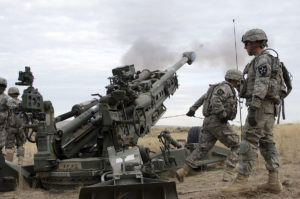HUNTSVILLE, Ala. — The Army’s recently completed tactical fires study concluded the service may be nearing “the end of the effectiveness of towed artillery,” a senior official said Wednesday.
Gen. James Rainey, head of Army Futures Command, provided additional details during remarks at AUSA’s Global Force Symposium on the yet-to-be-released study, which he noted affirmed the service’s pursuit of more mobile, indirect fires for light infantry and Stryker formations.

“I personally believe that we have witnessed the end of the effectiveness of towed artillery. The future is not bright for towed artillery,” Rainey said. “Displacement times against the high-end threat, like China, in terms of large-scale combat [operations], there can’t be displacement. Someone asked me what the standard is for no displacement. I said, ‘No displacement’” I mean, we’ve got to be faster. We’ve got to continuously move.”
The Army has been working on the study to inform its artillery priorities moving forward, while Rainey’s comments signal the service may be ready to move on from systems such as the BAE Systems-built M777 lightweight towed howitzer.
“We also realized that, when you’re talking about conventional artillery and fires, it’s probably more about capacity than capability. The structure, the depth of your magazine, when you’re in a resource-constrained environment [and thinking about] where you’re going to spend your money, you can go after an exquisite system or you can take a more holistic approach to delivering capability and capacity,” Rainey said of the study’s findings.
Rainey noted the tactical fires study also affirmed the Army must continue pursuing “a better armored howitzer” and added he’s interested in the potential for an “autonomous and robotic cannon system” for joint forcible entry formations.
“I think there’s huge opportunity with autonomous and robotic solutions to that, and not wed to any caliber,” Rainey said.
The Army also recently announced it has ended development of the Extended Range Cannon Artillery (ERCA) future howitzer system and will be pivoting to a new approach that will look to consider industry’s existing capabilities, with plans to assess more mature, existing offerings from industry this summer (Defense Daily, March 12).
Officials noted the decision was informed by the tactical fires study, while Rainey reiterated that the Army still maintains a requirement for getting after extended range of its cannon artillery capabilities.
“The requirement for extended range cannon artillery is a good requirement that remains valid. We did a real aggressive prototyping effort. We’ve learned from that. We’ve learned from the little bit of disruption in warfare that’s happened in the last couple of years. We’re paying attention. We’re going to deliver an extended range cannon capability and capacity,” Rainey told reporters on Tuesday here at the conference.
The ERCA development effort to date had focused around integrating an Army-developed 58-caliber, 30-foot gun tube on BAE Systems’ M109A7 self-propelled howitzer chassis with an aim to develop a system capable of hitting targets out to 70 kilometers at a rate of six to 10 rounds per minute.
Army officials had previously discussed engineering challenges with the ERCA development effort, to include excessive wear on the gun tube, which had delayed the planned timeline for the program.
“Nothing has changed about the requirement that we have to extend the range of our cannon artillery. We did a rapid prototyping effort and we watched what’s going on in Ukraine, and that led us to make an adjustment to ERCA,” Rainey said on Wednesday.
Doug Bush, the Army’s acquisition chief, told reporters a Request for Information notice to officially begin the post-ERCA effort will gather insight on industry’s potential offerings that could go through the evaluation this summer.
“We want to see what industry has on hand this summer through a series of evaluation events,” Bush said. “If that’s attractive to requirements holders, that would put us on a path to potentially selecting one next year to actually go into quick production off basically a… military off-the-shelf [capability] to get after the range issue…which is still there.”
“One thing about prototyping, this is where people talk about taking risks. They’re not all going to work out. The key thing is setting up the prototyping efforts where you gain knowledge early enough to make a decision to go in a different way or to go into production, either way before you’ve spent too much,” Bush added.